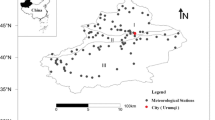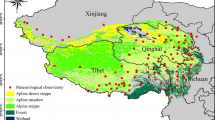Abstract
The phenology of the vegetation covering north Asia (mainly Siberia) and its spatial characterstics were investigated using remotely sensed normalized difference vegetation index (NDVI) data. The analysis used the weekly averaged NDVI over 5 years (1987–1991) using the second-generation weekly global vegetation index dataset (0.144°× 0.144° spatial resolution). In the seasonal NDVI cycle, three phenological events were defined for each pixel: green-up week (NDVI exceeds 0.2), maximum week, and senescence week (NDVI drops below 0.2). Generally there was a west-early/east-late gradient in the three events in north Asia. In the zonal transect between 45° and 50°N, the timing of green-up, maximum, and senescence near 60°E (Kazakh) was about 3.4, 8.7, and 13.4 weeks earlier than near 110°E (Mongolia) respectively. It has been suggested that vegetation near Kazakh only flourishes during a short period when water from snow melt is available from late spring to early summer. In Mongolia, abundant water is available for the vegetation, even in midsummer, because of precipitation. In the 50–60°N zonal transect, the green-up and maximum near 40°E were about 3.8 and 3.9 weeks earlier than near 115°E, respectively. As for the week of senescence, there was no clear west–east trend. This west-to-east phenological gradient was related to the weekly cumulative temperature (over 0 °C). Weeks in which the cumalative temperature exceeded 40 °C and 140 °C had a similar west-east distribution to green-up and maximum NDVI.











Similar content being viewed by others
References
Armstrong R (2001) Historical Soviet daily snow depth. Version 2 (HSDSD). National Snow and Ice Data Center, Boulder Colo. CD-ROM
Defries RS, Townshend JRG (1994) NDVI-derived land cover classifications at a global scale. Int J Remote Sens. 15:3567–3586
Di L-P, Lundquist DC, Han L-H (1994) Modelling relationships between NDVI and precipitation during vegetative growth cycles. Int J Remote Sens. 15:2121–2136
GAME-International Science Panel (1998) GEWEX Asian monsoon experiment (GAME) implementation plan. GAME-International Science Panel, GAME International Project Office, Hydrospheric Atmospheric Research Center, Nagoya University
Goward SN, Dye DG, Turner S, Yang J (1993) Objective assessment of the NOAA global vegetation index data product. Int J Remote Sens. 14:3365–3394
Gutman GG (1991) Monitoring land ecosystems using the NOAA global vegetation index dataset. Palaeogeogr Palaeoclimatol Palaeoecol (Global Planet Change Sect) 90:195–200
Gutman G (1999) On the use of long-term global data of land reflectance and vegetation indices derived from the advanced very high resolution radiometer. J Geophys Res 104:6241–6255
Holloway JL Jr (1958) Smoothing and filtering of time series and space fields. Adv Geophys 4:351–389
IPCC (1996) Climate change 1995: the science of climate change. In: Houghton JT, Meira Filho LG, Callander BA, Harris N, Kattenberg A, Maskell K (eds) Contribution of working group I to the second assessment report of the Intergovernmental Panel on Climate Change. Cambridge University Press, Cambridge
IPCC (2001) Climate change 2001: the scientific basis. In: Houghton JT, Ding Y, Griggs DJ, Noguer M, Linden PJ van der, Dai X, Maskell K, Johnson CA (eds) Contribution of working group I to the third assessment report of the Intergovernmental Panel on Climate Change. Cambridge University Press, Cambridge
Kawabata A, Ichii K, Yamaguchi Y (2001) Global monitoring of interannual changes in vegetation activities using NDVI and its relationships to temperature and precipitation. Int J Remote Sens. 22:1377–1382
Kidwell KB (1990) Global vegetation index user's guide. U.S. Department of Commerce, NOAA, NESDIS, NCDC, SDSD
Kira T (1948) On the altitudinal arrangement of climatic zones in Japan. A contribution to the rational land utilization in cool highlands. Agric Sci North Temperate Region 2:143–173 (in Japanese)
Lloyd D (1990) A phenological classification of terrestrial vegetation cover using shortwave vegetation index imagery. Int J Remote Sens. 11:2269–2279
Loveland TR, Reed BC, Brown JF, Ohlen DO, Zhu J, Yang L, Merchant JW (2000) Development of a global land cover characteristics database and IGBP DISCover from 1-km AVHRR Data. Int J Remote Sens. 21:1303–1330
Malingreau J-P (1986) Global vegetation dynamics: satellite observations over Asia. Int J Remote Sens 7:1121–1146
Masuda K, Morinaga Y, Numaguti A, Abe-Ouchi A (1993) The annual cycle of snow cover extent over the Northern Hemisphere as revealed by NOAA/NESDIS satellite data. Geogr Rep Tokyo Metropolitan University 28:113–132
Moulin S, Kergoat L, Viovy N, Dedieu G (1997) Global-scale assessment of vegetation phenology using NOAA/AVHRR satellite measurements. J Clim 10:1154–1170
Myneni RB, Keeling CD, Tucker CJ, Asrar G, Nemani RR (1997) Increased plant growth in the northern high latitudes from 1981 to 1991. Nature 386:698–701
Myneni RB, Tucker CJ, Asrar G, Keeling CD (1998) Interannual variations in satellite-sensed vegetation index data from 1981 to 1991. J Geophys Res 103:6145–6160
National Climatic Data Center (1994) Global daily summary (CD-ROM)
National Climatic Data Center (2001) Federal climate complex global surface summary of data version 6 (ftp://ftp.ncdc.noaa.gov/)
Nicholson SE, Davenport ML, Malo AR (1990) A comparison of the vegetation response to rainfall in the Sahel and East Africa, using normalized difference vegetation index from NOAA AVHRR. Clim Change 17:209–241
Norwine J, Greegor DH (1983) Vegetation classification based on advanced very high resolution radiometer (AVHRR) satellite imagery. Remote Sens Environ 13:69–87
Reed BC, Brown JF, VanderZee D, Loveland TR, Merchant JW, Ohlen DO (1994) Measuring phenological variability from satellite imagery. J Veg Sci 5:703–714
Robock A, Vinnikov KY, Srinivasan G, Entin JK, Hollinger SE, Speranskaya NA, Liu S, Namkhai A (2000) The global soil moisture data bank. Bull Am Meteorol Soc 81:1281–1299
Schwarts MD (1994) Monitoring global change with phenology: the case of the spring green wave. Int Biometeorol 38:18–22
Shinoda M (1995) Seasonal phase lag between rainfall and vegetation activity in tropical Africa as revealed by NOAA satellite data. Int J Climatol 15:639–656
Suzuki R, Yatagai A, Yasunari T (1998) Satellite-derived vegetation index and evapotranspiration estimated by using assimilated atmospheric data over Asia. J Meteorol Soc Jpn 76:663–671
Suzuki R, Tanaka S, Yasunari T (2000) Relationships between meridional profiles of satellite-derived vegetation index (NDVI) and climate over Siberia. Int J Climatol 20:955–967
Suzuki R, Nomaki T, Yasunari T (2001a) Spatial distribution and its seasonality of satellite-derived vegetation index (NDVI) and climate in Siberia. Int J Climatol 21:1321-1335
Suzuki R, Yoshikawa K, Maximov TC (2001b) phenological photographs of Siberian larch forest from 1997 to 2000 at Spasskaya Pad, Republic of Sakha, Russia. http://picard.suiri.tsukuba.ac.jp/~siberia/spaphoto/index/index.htm
Tarpley JD (1991) The NOAA global vegetation index product – a review. Palaeogeorgr Palaeoclimatol Palaeoecol (Global Planet Change Sect) 90:189–194
Tarpley JD, Schneider SR, Money RL (1984) Global vegetation indices from the NOAA-7 meteorological satellite. J Clim Appl Meteorol 23:491–494
Tucker CJ, Fung IY, Keeling CD, Gammon RH (1986) Relationship between atmospheric CO2 variations and a satellite-derived vegetation index. Nature 319:195–199
Tucker CJ, Slayback DA, Pinzon JE, Los SO, Myneni RB, Taylor MG (2001) Higher northern latitude normalized difference vegetation index and growing season trends from 1982 to 1999. Int J Biometeorol 45:184–190
Walter H (1973) Vegetation of the earth in relation to climate and the eco-physiological condition (translated by Wieser J.) Springer, New York, Berlin Heidelberg
Wessel P, Smith WHF (1991) Free software helps map and display data. EOS Trans AGU 72:441, 445–446
White MA, Thornton PE, Running SW (1997) A continental phenology model for monitoring vegetation responses to interannual climatic variability. Global Biogeochemical Cycles 11:217–234
Woodward FI (1987) Climate and plant distribution. Cambridge University Press, Cambridge
Ye H, Cho H-R, Gustafson PE (1998) The change in Russian winter snow accumulation during 1936–83 and its spatial patterns. J Clim 11:856–863
Acknowledgements
The authors thank Dr. Dennis Dye (Frontier Research System for Global Change) for his suggestions and advice, and the referees for their useful comments, which contributed to the final version of the manuscript. All the pictures were constructed with the help of the GMT System (Wessel and Smith 1991). This study was partly supported by a grant-in-aid of scientific research from the Ministry of Education, Science, Sports, and Culture, Japan ("Better Understanding of Water and Energy Circulation on a Continental Scale based on Satellite Remote Sensing"; 08241105).
Author information
Authors and Affiliations
Corresponding author
Rights and permissions
About this article
Cite this article
Suzuki, R., Nomaki, T. & Yasunari, T. West–east contrast of phenology and climate in northern Asia revealed using a remotely sensed vegetation index. Int J Biometeorol 47, 126–138 (2003). https://doi.org/10.1007/s00484-003-0164-4
Received:
Revised:
Accepted:
Published:
Issue Date:
DOI: https://doi.org/10.1007/s00484-003-0164-4




